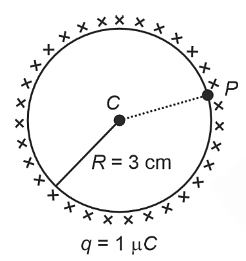Electric potential at a point \( P \) due to a point charge of \( 5 \times 10^{-9} \, \text{C} \) is \( 50 \, \text{V} \). The distance of \( P \) from the point charge is:
- 90 cm
- 70 cm
- 60 cm
- 50 cm
The Correct Option is A
Solution and Explanation
The electric potential \( V \) at a point due to a point charge \( q \) is given by: \[ V = \frac{1}{4 \pi \epsilon_0} \cdot \frac{q}{r}, \] where: - \( V \) is the electric potential, - \( q = 5 \times 10^{-9} \, \text{C} \) (charge), - \( r \) is the distance of the point from the charge, - \( \frac{1}{4 \pi \epsilon_0} = 9 \times 10^9 \, \text{Nm}^2\text{C}^{-2} \).
Step 1: Rearrange the formula to solve for \( r \). Rearranging: \[ r = \frac{1}{4 \pi \epsilon_0} \cdot \frac{q}{V}. \]
Step 2: Substitute the known values. Substitute \( V = 50 \, \text{V} \), \( q = 5 \times 10^{-9} \, \text{C} \), and \( \frac{1}{4 \pi \epsilon_0} = 9 \times 10^9 \): \[ r = \frac{9 \times 10^9 \cdot 5 \times 10^{-9}}{50}. \]
Step 3: Simplify the calculation. \[ r = \frac{45}{50} = 0.9 \, \text{m}. \] Convert \( r \) to centimeters: \[ r = 0.9 \, \text{m} \times 100 = 90 \, \text{cm}. \]
Final Answer: The distance of \( P \) from the point charge is: \[ \boxed{90 \, \text{cm}}. \]
Top Questions on Electric Potential And Potential Difference
- If a particle of mass 10 mg and charge 2 µC at rest is subjected to a uniform electric field of potential difference 160 V, then the velocity acquired by the particle is
- TS EAMCET - 2025
- Physics
- Electric Potential And Potential Difference
- A thin spherical shell is charged by some source. The potential difference between the two points C and P (in V) shown in the figure is:
(Take \(\frac{1}{4}\pi\epsilon_0 = 9 × 109\)\(\frac{1}{4\pi\epsilon_0}=9\times10^9\) SI units)
- NEET (UG) - 2024
- Physics
- Electric Potential And Potential Difference
- A charge of 10 coulomb is brought from infinity to a point \( P \) near a charged body and in this process 200 joules of work is done. Electric potential at point \( P \) is:
- JEECUP - 2024
- Physics
- Electric Potential And Potential Difference
- Two point charges \( 20 \, \mu C \) and \( -10 \, \mu C \) are separated by a distance of 1 m in air. At what point on the line joining the two charges, the electric potential is zero.
- COMEDK UGET - 2023
- Physics
- Electric Potential And Potential Difference
- Choose correct graph of electric potential for uniformly charged hollow sphere.
- JEE Main - 2023
- Physics
- Electric Potential And Potential Difference
Questions Asked in JEE Main exam
- Match List - I with List - II. List - I (Partial Derivatives) \(and\) List - II (Thermodynamic Quantity)

In the light of the above statements, choose the correct answer from the options given below:- JEE Main - 2025
- Thermodynamics
- Let $ \vec{a} $ and $ \vec{b} $ be the vectors of the same magnitude such that $ \frac{| \vec{a} + \vec{b} | + | \vec{a} - \vec{b} |}{| \vec{a} + \vec{b} | - | \vec{a} - \vec{b} |} = \sqrt{2} + 1. \quad \text{Then } \frac{| \vec{a} + \vec{b} |^2}{| \vec{a} |^2} \text{ is:} $
- JEE Main - 2025
- Vector Algebra
- Let the distance between two parallel lines be 5 units and a point \( P \) lies between the lines at a unit distance from one of them. An equilateral triangle \( POR \) is formed such that \( Q \) lies on one of the parallel lines, while \( R \) lies on the other. Then \( (QR)^2 \) is equal to _____________.
- JEE Main - 2025
- Coordinate Geometry
Let \( a \in \mathbb{R} \) and \( A \) be a matrix of order \( 3 \times 3 \) such that \( \det(A) = -4 \) and \[ A + I = \begin{bmatrix} 1 & a & 1 \\ 2 & 1 & 0 \\ a & 1 & 2 \end{bmatrix} \] where \( I \) is the identity matrix of order \( 3 \times 3 \).
If \( \det\left( (a + 1) \cdot \text{adj}\left( (a - 1) A \right) \right) \) is \( 2^m 3^n \), \( m, n \in \{ 0, 1, 2, \dots, 20 \} \), then \( m + n \) is equal to:
- JEE Main - 2025
- Determinants
- Let $ A = \left\{ \theta \in [0, 2\pi] : \Re\left( \frac{2 \cos \theta + i \sin \theta}{\cos \theta - 3i \sin \theta} \right) = 0 \right\} $. Then $ \sum_{\theta \in A} \theta^2 $ is equal to:
- JEE Main - 2025
- Trigonometric Equations